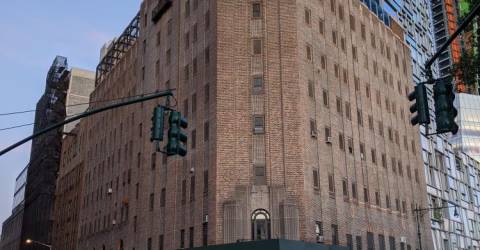
At eight stories tall and with a lot size of 15,800 square feet, the 1931 Art Deco building at 550 W. 20th Street in West Chelsea has served many purposes — from a boarding house for merchant sailors docked on the Hudson, to a women’s correctional facility with the nation’s highest rate of guard-on-prisoner sexual abuse.
On Tuesday, September 26th, Gov. Kathy Hochul ushered in the beginning of its next chapter: a residential development with low-income affordable housing, at least 60 units of supportive housing, at least 15 units of short-term transitional housing, and a community center. Neighbored by luxury condos, the IAC Building, and the High Line, the development program will be funded by Empire State Development, New York State Homes and Community Renewal, and the New York State Office of Mental Health, and fill the housing needs of low- and moderate-income and unhoused New Yorkers in the West Chelsea community.
The Bayview Correctional Facility redevelopment project is part of Gov. Hochul’s five-year, $25 billion housing plan to build or preserve 100,000 affordable homes. It incorporates Manhattan Community Board 4’s Bayview redevelopment plan — part of its Affordable Housing plan unveiled in December of last year, which called for the creation and preservation of 14,686 affordable housing units in its district.
The plan is “a huge victory for the west side of Manhattan, and the state of New York,” CB4 Chair Jeffrey LeFrancois said in Gov. Hochul’s press release. “The housing crisis affects every corner of society, and this project will begin to address the needs of our most vulnerable neighbors, bringing supportive housing and services to one site — and the community is honored to be home to this facility.”
From Boarding House to Notorious Prison
For the past eight years, the hulking brick building at 550 W. 20th Street has sat vacant. If passersby look closely, they’ll find hints of its origins in the sea motifs embedded in its brick facade. In 1931, it was a gleaming new eight-story boarding house for merchant sailors designed by Shreve, Lamb & Harmon, the same architecture firm that had just completed what was then the world’s tallest skyscraper — the Empire State Building.
By the 1960s, the Chelsea Piers saw the last of its cargo and passenger ships, and in 1967, the YMCA sold the Seamen’s House to the city of New York. For 11 years, it was, in turn, a drug treatment center, a work release facility, and a detention center. In 1978, the state converted it to Bayview Correctional Facility—what would become, in the next 35 years, a medium-security women’s prison notorious for sexual abuse.
In 1985, the Correctional Association of New York released a report describing widespread sexual abuse of incarcerated women by male prison guards, ranging “from verbal harassment to coerced sexual contact.” Over two decades later, in 2008 and 2009, 11.5 percent of the women held in Bayview alleged experiencing sexual abuse perpetrated by prison guards—the highest rate of all the prisons in the nation, as reported by City Limits at the time. “It was really a dark place for women to be,” Marcie Chase, who was imprisoned in Bayview in the ‘80s, told Chelsea News in 2016. Last year, as the Adult Survivors Act took effect, over 750 people sued the State of New York for the abuse they experienced in prisons. Many of them had been incarcerated in Bayview.
In 2012, Hurricane Sandy battered and flooded the prison, which had been evacuated ahead of the superstorm’s landing. The building stood vacant in the aftermath, and in 2013, Bayview was decommissioned by then-Gov. Andrew Cuomo. In the following year, Empire State Development announced that 550 W. 20th St. was once again available for redevelopment. The NoVo Foundation—founded by Peter Buffett, the son billionaire investor and philanthropist Warren Buffet’s—placed the winning bid in 2015, unveiling plans to transform it to a hub for women’s organizing and activism. The building, that was notorious for women’s abuse and neglect, was to become the “Women’s Building”: a bastion of social justice and hope that, as the project’s website describes, “stands for what’s possible when the potential of girls and women is nurtured.” That is, until the Novo Foundation terminated the plan in 2019, stating that the project’s timeline and budgets “far exceeded original estimates.”
The Preservation of an Architectural Landmark
While the Bayview building carries a heavy history, community members have been adamant about its preservation as a historical and architectural landmark. In a 2013 letter to the Landmarks Committee, CB4 wrote of the building’s architectural merits and “character defining embodiment of neighborhood history,” though the building failed to gain a landmark designation. In his architecture blog, ArchiTakes, Chelsea resident and architect Dave Holokwa wrote fondly of the building’s unique characteristics, such as the “stylized ships’ prows, waves, and Jazz Age riffs on the YMCA’s triangle logo” that “are deployed for maximum effect, lighting up the building’s roof line and window heads.” Interior photos in an amNY article depict original details: stained glass windows, a small chapel with a nautical mural, and a swimming pool lined with intricate marine-themed mosaics.
Community members may then be pleased to hear that one of the objectives in the Bayview request for proposals specifies is the “preservation and adaptive reuse to the extent feasible, of the historic building and features.”
Empire State Development is accepting proposals until December 13, 2023, 5:00 p.m.
This post was originally published on this site be sure to check out more of their content.






